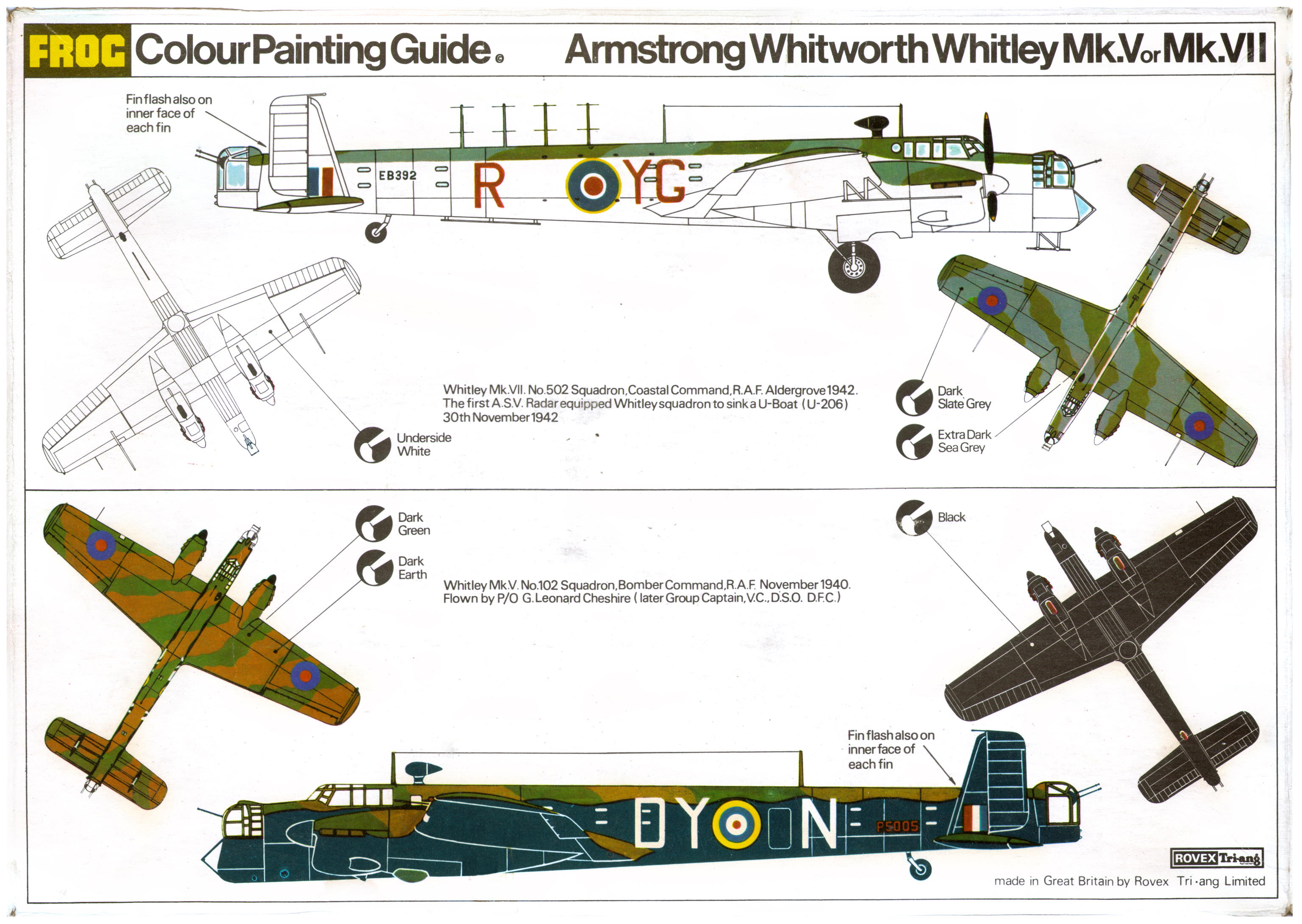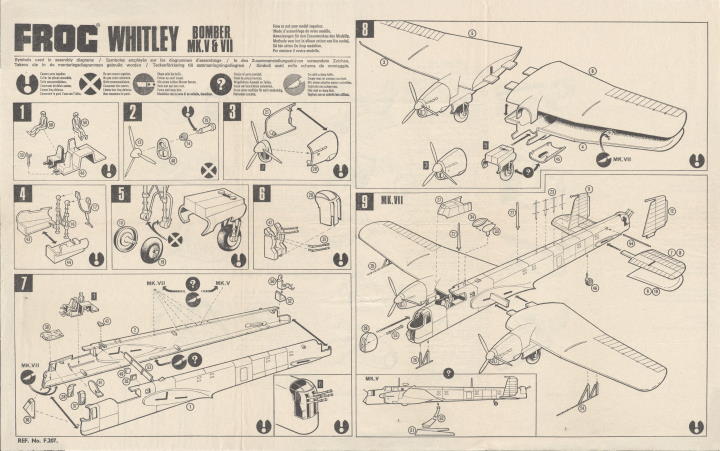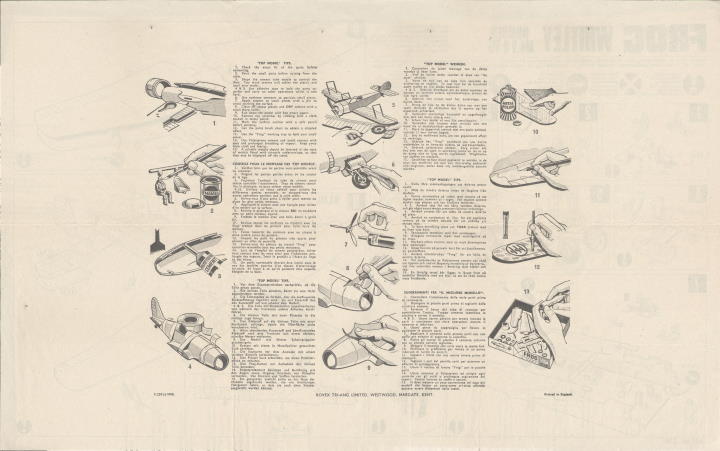










Armstrong Whitworth 207/217 Whitley V/VII
| F207 | 1970-1973 | G2 | 55000 | 2xRAF |
FROG model aircraft 1932-1976, R. Lines, L. Hellstrom
|
|
NEW AND IN VIEW NEW AIRCRAFT KITS
FROG TRI-ANG LTD. Armstrong Whitworth Whitley Mks. V/VII. масштаб 1/72. 17/6 пенсов. (U.K.)
Один из самых нетерпеливо ожидаемых пластиковых наборов - это новый набор от FROG, посвященный самолету Whitley, и его качество с лихвой компенсирует некоторые из менее качественных продуктов, выпущенных в последнее время. Поскольку Whitley был довольно большим самолетом, цена в 17/6 пенсов не является неоправданной. Модель отлита из белого полистирола, детализация панелей и линий превосходна. Сборка довольно проста, а подгонка деталей заслуживает высокой оценки, особенно крыльев и мотогондол двигателей. Последние очень просты и состоят из «тела» мотогондолы отливаемой интегрально с половинками крыльев, и передних частей «капотов» рядных двигателей, отлитых из двух половинок, которые очень точно стыкуются с передней частью мотогондолы, линия соединения находится в том же положении, что и на реальной машине, обеспечивая тем самым правильный эффект горки.
Декали, которые также очень хороши, предназначены для Mk. V в маркировке (тогдашнего) Flying Officer Г. Леонарда Чешира, на котором он немедленно получил D.S.O. в ноябре 1940 года, а альтернативная маркировка предназначены для Mk.VII A.S.V., оснащенного радаром, из 502 Squadron Coastal Command - антенный массив радара A.S.V. предоставляется в качестве альтернативных дополнительных деталей.
Шасси прочные и очень реалистичные, а точность этого набора не вызывает сомнений, поскольку он был нарисован и изготовлен по оригинальным полноразмерным чертежам, которые стали известны около двух лет назад, доказывая тем самым, что если производитель в состоянии получить точные чертежи, то нет причин, по которым все его наборы не должны соответствовать минимальным стандартам точности - начертить и изготовить инструменты и пресс-формы по точным чертежам стоит столько же, сколько и по неточным, с учетом определенных технических или коммерческих ограничений.
Из всех наборов FROG мы серьезно оцениваем этот как один из лучших на сегодняшний день.
The IPMS magazine, MARCH 1970. VOL. 7 No. 3
Мир моделизма
ДЖЕЙМС ГОЛДИНГ
"Летающая дверь сарая" от Frog
Несмотря на то, что Armstrong Whitworth Whitley был важным самолетом в начале Второй мировой войны, он, по какой-то непонятной причине, до сих пор полностью игнорировался всеми производителями наборов. К счастью, компания Frog исправила ситуацию, выпустив набор в 1/72, который восхитительно соответствует полноразмерному объекту. Из набора можно собрать либо стандартный Mk V, использовавшийся в ранних наступательных операциях Бомбардировочного командования, либо морской разведчик Mk VII, который выполнял столь важную работу по поиску подводных лодок. Обе версии, разумеется, оснащались двумя двигателями Rolls-Royce Merlins, и обе были в основном похожи, за исключением оборудования. Whitley V был «чистым» самолетом с небольшим количеством внешних излишеств, в то время как Mk VII может понравиться многим моделистам благодаря огромному количеству радарных антенн и монтажных мачт. Электронная оснастка, предусмотренная в наборе для Mk VII, включает верхние мачты на задней части фюзеляжа, кронштейн под носом и два кронштейна под крылом, которые должны быть наклонены под углом 20 градусов к линии полета. К сожалению, диполи были отлиты только на верхних мачтах, что очень жаль, поскольку они являются заметной особенностью этих антенн. В этом случае моделисту предстоит много часов утомительной работы по добавлению этих маленьких стержней. Я считаю, что было бы лучше отлить носовую и подкрыльевую штанги и диполи как цельные, плоские, самостоятельные детали, и отдельно вертикальные держатели. Это, возможно, немного увеличило бы стоимость набора, но я уверен, что моделисты с этим смирились бы. Боковые антенны, установленные в хвостовой части фюзеляжа, были упущены, что опять же вызывает сожаление. Использовались две различные версии этих антенн: одна состояла из восьми одностержневых креплений с каждой стороны фюзеляжа, а другая - из непрерывной проволочной антенны, установленной в виде прямоугольника вблизи бортов фюзеляжа. Только первый вариант мог бы быть отлит.
На основных деталях набора отверстия для крепления антенн Mk VII были просверлены лишь частично, так что для бомбардировщика их зашпаклёвывть не требуется. Переводная маркировка для морского варианта предназначена для самолета 502-й эскадрильи Берегового командования, базировавшейся в Олдергроуве, графство Антрим, Северная Ирландия. Этот конкретный Whitley был окрашен в стандартные цвета схемы Temperate Sea: Extra Dark Sea Grey и Dark Slate Grey на верхних поверхностях, и полностью белый на нижних поверхностях. Моделисты должны обратить внимание на то, что в таблице цветов на обратной стороне коробки с набором названия цветов поменялись местами. Dark Slate Grey - это «зеленый» оттенок, а не указанный сине-серый. Начиная со 2 февраля 1943 года, было принято официальное постановление о том, что Dark Slate Grey должен быть удален из схемы Temperate Sea, оставив все верхние поверхности Extra Dark Sea Grey. Глянцевая отделка была нанесена на все белые нижние поверхности, но борта фюзеляжа остались матово-белыми. Хотя эта схема, несомненно, применялась на Whitley VII, 502-я эскадрилья перевооружалась на Halifax'ы примерно во время смены цветовой схемы, поэтому маловероятно, что ее Whitley были перекрашены по новой схеме.
Объектом для переводной маркировки для Whitley V стал P5005 DY-N из 102-й эскадрильи, Линтон-на-Узе, самолет, которым управлял Командир группы Леонард Чешир (Grp Capt Leonard Cheshire VC, DSO, DFC, как он сейчас называется) 12/13 ноября 1940 года, когда он получил свой DSO. (Историю и фотографию P5005 см. в апрельском номере.) На переводном листе для этого «Уитли» код эскадрильи и буквы самолета напечатаны белым цветом, но я считаю, что они должны были быть окрашены в серый цвет, возможно, в цвет MAP, известный как Sky Grey. На вышеупомянутой фотографии P5005 видны очень светлые буквы, которые можно принять за белые. Однако при оценке цветов на черно-белых фотографиях следует соблюдать осторожность, поскольку отпечатки, сделанные на «жесткой» бумаге, могут давать преувеличенный контраст, и тон, который кажется белым, на самом деле может таковым не являться. С 1938 года до середины мая 1942 года кодовые буквы бомбардировщиков и истребителей обычно были серыми. Серая краска, использовавшаяся в 1938 и 1939 годах, была определена Министерством авиации и фактически имела тот же номер спецификации, что и Medium Sea Grey, когда этот цвет был впервые применен на нижних поверхностях истребителей. (Хотя этот цвет использовался эскадрильями в течение нескольких лет, название Medium Sea Grey, похоже, не применялось к этому серому цвету до тех пор, пока он не стал стандартным оттенком для окраски поверхности. И хотя оттенок оставался неизменным, на протяжении своей жизни этот серый имел несколько номеров спецификации краски). Начиная с 1940 года и вплоть до введения букв Dull Red, есть свидетельства того, что Sky Grey также использовался для кодовых букв, и, вероятно, именно по этой причине многие люди и публикации в прошлом указывали «светло-голубой» как используемый для этих букв. Sky Grey был бледнее, чем Medium Sea Grey, и при определенном освещении мог быть принят за бледно-голубой.
По мере увеличения числа ночных рейдов Бомбардировочного командования в 1940 году все чаще высказывалось мнение, что серые буквы и использовавшиеся в то время фюзеляжные круги Type A1 слишком заметны и ярки при освещении прожекторами. В связи с этим многие эскадрильи все чаще наносили на эти знаки темную краску, чтобы приглушить их. В конце концов, в мае 1942 года в RAF были введены новые стандартные круги на самолетах Type С и C1, а также полосы на оперении с использованием узких желтых и белых колец. Вместе с новой маркировкой появился и новый цвет, Dull Red, который использовался для красного цвета в национальной маркировке и для кодовых букв вместо серого на всех бомбардировщиках, кроме Mosquito. (Москито, из-за его невероятных характеристик, был окрашен в цвета дневного истребителя, чтобы скрыть свою роль бомбардировщика). Учитывая озабоченность по поводу яркости существующих букв и кругов, я не могу поверить, что белые кодовые буквы когда-либо использовались на бомбардировщиках, летавших над вражеской территорией в годы войны.
Что касается модели в целом, то стыковка деталей отличная, но следует сделать одно предостережение. Толщина стенок деталей кажется тоньше, чем обычно для модели такого размера, и моделист должен следить за тем, чтобы внутрь не попало слишком много клея, из-за чего стенки могут легко расплавиться и разрушиться.
Шасси в положении «выпущено» крепится к основанию, в котором тнтегрально отльиты створки. Я очень люблю эту систему, которая с успехом использовалась на нескольких моделях Airfix. Она работает великолепно, а створки намного прочнее, чем при старом методе крепления каждой створки по отдельности. В набор также включены детали закрытых створок с слегка выступающими колесами для тех моделистов, которые любят выставлять модель с убранными шасси.
Турели не подвижны, но это вряд ли оскорбит многих серьезных моделистов, хотя и может разочаровать молодых энтузиастов. Небольшая поправка требуется в отношении передней турели. Она установлена с выступающей губой над смотровым люком бомбардира, в то время как на самом деле она была прекрасно закреплена заподлицо. Исправление осуществляется довольно просто: нужно срезать углубление для турели в носовой части фюзеляжа и сточить губу напильником. При этом турель также устанавливается ближе к боковому остеклению в кормовой части, что опять же более правильно. По какой-то причине окно бомбардира смещено на модели, но на настоящем Whitley такого точно не было.
Два элемента на этой модели, которые можно было бы улучшить, это каналы радиаторов и пропеллеры. Воздухозаборники радиаторов довольно мелкие, в то время как на настоящем самолете они были глубоко утоплены. Более глубокие воздухозаборники, несомненно, не вызвали бы проблем с литьем и улучшили бы внешний вид двигателей.Лопасти пропеллера довольно хлипкие (подобный недостаток был замечен в Frog Tomahawk), и было бы неплохо улучшить форму их изготовления. Коки также слишком малы. Пропеллеры и коки на Whitley V и VII были закругленного типа Rotol. Их цельнодеревянные лопасти были довольно толстыми по сравнению с современными типами de Havilland. Пропеллер Rotol, предназначенный для двигателей Merlin, имел стандартный диаметр кока, разработанный для одного конкретного типа самолета и адаптированный для использования на других типах. Он прекрасно вписывался в носовые обводы «Спитфайра», вероятно, будучи разработанным для этого типа, и довольно хорошо подходил к обводам «Fulmar». Но он был слишком большим для «Уитли» и «Харрикейна», что приводило к тому, что кок оказывался слишком большим для существующих обводов фюзеляжа или мотогондол. Однако уменьшение обводов, по-видимому, не оказало чрезмерного влияния на характеристики, а производственные преимущества компенсировали любые эстетические соображения. Прототип Merlin Whitley имел пропеллеры de Havilland, вокруг которых и были спроектированы контуры мотогондолы, но когда для серийных самолетов был принят пропеллер Rotol, переделка мотогондолы не проводилась.
Frog Whitley имеет очень легкую детализацию поверхности. Много раз в прошлом я критиковал модели за чрезмерно тяжелую детализацию поверхности, но в данном случае мне понравилась бы более интенсивная гравировка, особенно на крыле. Она настолько тонкая, что при окрашивании становится незаметной. Поверхность крыла в хвостовой части массивного коробчатого лонжерона была обшита тканью, и внешний вид модели был бы улучшен, если бы можно было смоделировать участки ткани.
Frog Whitley поддается многим интересным конверсиям. Mk IV прост, только кили и задняя часть фюзеляжа требуют изменений. Mk II и III более амбициозны, их конверсия также включает установку радиальных двигателей Tiger, задней турели типа Armstrong Whitworth, а в случае Mk II - и носовой турели AW. Самым сложным будет оригинальный Mk I, который в целом был похож на II и III, но не имел поперечного V-крыла у консолей. Мк I, II и III также имели нижнте турели-«пылесборники». Интересной гражданской конверсией могут стать версии BOAC без турелей, окрашенные в Dark Green и Dark Earth, с алюминиевыми нижними поверхностями, но проблема здесь может заключаться в очевидном отсутствии схем окраски; существует очень мало фотографий, и BOAC Whitleys могли иметь совсем другой камуфляж, чем машины Бомбардировочного командования, как и в случае с BOAC Mosquitoes. Еще одним вариантом, конечно, являются парашютные учебные Mk III и варианты буксировщиков планеров. Существовало множество вариантов, из которых можно выбирать.
Все критические замечания, которые я высказал, не умаляют достоинств очень хорошей базовой модели, которая обладает, прежде всего, одним существенным качеством - точными очертаниями.
Цена этого набора составляет 17 шиллингов 6 пенсов
Дж.Г.
AIRCRAFT Illustrated, июнь 1970
Тема обложки
С большим нетерпением мы открыли коробку, полученную недавно от компании ROVEX TRI-ANG LIMITED (FROG), в которой находился их новый набор ARMSTRONG WHITWORTH WHITLEY MK. V&VII. Придя в восторг от моделей, представленных на их выставке, мы с нетерпением ждали, когда же мы увидим, как выглядит серийный набор.
Нам не стоило беспокоиться. Этот набор, должно быть, один из лучших, выпущенных этой компанией на сегодняшний день. Отлитый из белого полистирола, детализация поверхности может быть описана только как превосходная, а подгонка деталей такова, что крылья и хвостовое оперение, при необходимости, могут быть просто вставлены на место, а не приклеены, что, безусловно, понравится тем, кто любит хранить свои модели или перевозить их с собой, как это делают, например, члены I.P.M.S. на различных соревнованиях и выставках.
Сборка происходит в соответствии с обычной практикой, и уже знакомая иллюстрированная пошаговая инструкция не оставляет сомнений в том, какие детали куда идут в том или ином варианте.
Набор может быть собран либо как бомбардировщик Mk. V в маркировке машины, на которой в 1940 году в составе 102 эскадрильи Леонард Чешир немедленно награжденный DSO, либо как машина Mk. VII, оснащенная радаром, из 502 эскадрильи Берегового командования. Версия бомбардировщика может быть собрана прямо из коробки, никаких модификаций для завершения набора в этом варианте не требуется. Однако для варианта Берегового командования потребуется открыть предварительно просверленные вставки на внутренней стороне крыльев и половин фюзеляжа, чтобы можно было вставить и закрепить на месте антенны радара. Единственное изменение, которое требуется от модели, относится и к модификации для Берегового командования. Антенны радара, установленные на крыле, должны быть наклонены наружу, а не направлены прямо вперед, как это окажется, если следовать инструкции и рисунку на коробке. Чтобы исправить эту незначительную ошибку, откройте только одно из просверленных отверстий на внутренней стороне нижних половинок крыла и удалите фиксирующий штифт из задней части стойки радара; затем, убедившись, что оставшийся штифт правильно входит в переднее фиксирующее отверстие, аккуратно поверните всю антенну так, чтобы она была направлена под углом примерно 70 градусов наружу к основному лонжерону крыла. ...Обратитесь к любым фотографиям самолетов «Уитли» Берегового командования, иллюстрирующие этот момент.
Кроме того, хотя небольшие продолговатые окна фюзеляжа представлены в наборе слегка приподнятыми линиями панелей, перед окраской модели очень внимательно проверьте, были ли эти окна закрашены в эскадрилье. Это часто делалось, особенно на самолетах Берегового командования Mk. VII, когда они часто оставляли неокрашенным группу из четырех окон в хвостовой части у входной двери фюзеляжа.
Детали интерьера состоят из сиденья пилота и пола отсека экипажа, который также включает в себя отливку для стола штурмана и второго сиденья пилота... бомбоприцел отлит интегрально со своей частью «пола», но те, кто хочет отказаться от фигурок экипажа, могут легко изготовить новый «пол» из обрезков пластика и т.д.
Шасси отлито с основными створками, прикрепленными к вставкам, которые помещаются внутрь мотогондол, что, в свою очередь, приводит к тому, что шасси полностью состоит из опор с маслоамортизаторами; однако, если вы хотите установить модель на подставку, то у вас есть альтернативные цельные вставки с выступающими «колесами», как на настоящей машине, которые вы можете использовать вместо «открытого» узла.
Прозрачные детали отличаются кристальной прозрачностью и плотным прилеганием, а деталь хвостовой пулеметной турели включает отдельные блоки крепления/казенника для четырех пулеметов.
Одна довольно странная ошибка встречается в иллюстрации на коробке: на лицевой стороне коробки изображен Уитли берегового командования с двумя пулеметами в носовой турели, что является художественным излишеством, поскольку Уитли несли только один носовой пулемет, как и предусмотрено в наборе!
Декали также очень хороши, они имеют плоскую матовую поверхность с очень близкими к точным оттенками синего и красного цветов.
Руководство по камуфляжу и окраске на обратной стороне коробки также выполнено на очень высоком уровне, но полиграфисты допустили ошибку: на машине Coastal Command область, обозначенная как Dark Slate Grey, должна быть окрашена в Extra Dark Sea Grey, а область, обозначенная как Extra Dark Sea Grey, должна быть Dark Slate Grey... Фактические цвета на коробке нарисованы правильно, просто подписи к цветам как-то поменялись местами.
Scale Models No.10 1970 ИЮЛЬ Том 1 No.10
Последние наборы
Frog Whitley
Появление этого набора на рынке - важное событие, поскольку он закрывает последний большой пробел в доступных моделях действующих типов R.A.F. во Второй мировой войне. Whitley был зверем необычной формы и обладал уникальеым видом на стоянке, словно бы он постоянно спотыкался о собственные ноги, а законцовки крыльев вполне могли вдохновить McDonnell на идеи для Phantom. Поэтому, чтобы сделать реалистичную модель, Frog пришлось добиться правильного угла между крылом и фюзеляжем и правильного угла поперечного V консолей крыла. К их чести, они хорошо проработали эти детали, и модель «сидит» правильно как на земле, так и в воздухе. Для этого предусмотрена планка жесткости, проходящая через фюзеляж и оба корня крыльев; сами крылья требуют довольно много работы, чтобы плотно прилегать к фюзеляжу, а стыки мотогондол и двигателей не очень хорошо сопрягаются. Все остальные детали, однако, не представляют проблем при сборке. Прозрачные детали хорошо детализированы, литье чистое, а линии панелей тонкие, настолько тонкие, что предпочтительно использовать только один слой краски, если это возможно, чтобы сохранить детализацию.
Frog оказались достаточно дальновидными, чтобы предоставить в качестве альтернативы бомбардировщику версию Mk. VII Берегового командования, которая была введена в эксплуатацию в качестве временной меры до появления таких машин, как «Либерэйторы» (и которая обеспечивала аппетитные мишени для Ju 88 над Бискаем в 1942-3 годах). Это предполагает установку антенн A.S.V. в верхней части фюзеляжа, под носом и под крыльями. Последние должны быть разнесены под углом, как показано на крышке передней коробки, а не выровнены по носу и хвосту, как в наборе; для придания реалистичности следует добавить настоящие поперечные антенны на этих стойках, подходящим материалом для которых может послужить плавкая проволока или тянутый литник. Боковые фюзеляжные антенны также должны быть сделаны для завершения самолета, оснащенного A.S.V. Отличный переводной лист прилагается для самолета Whitley V из 102-й эскадрильи, на котором Леонард Чешир, в то время P/O., вернулся из Кельна в ноябре 1940 года с большой пробоиной в борту, или Coastal Mk. VII из 502-й эскадрильи.
Air Pictorial Vol. 32 No. 7 July 1970
|




